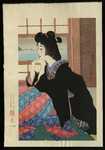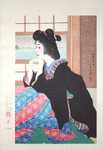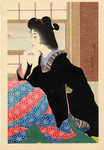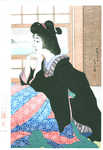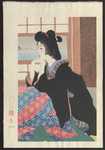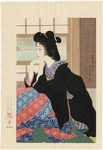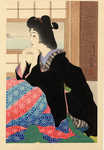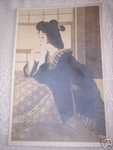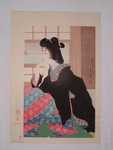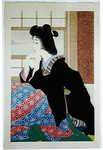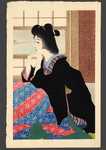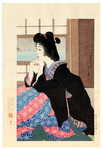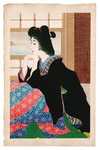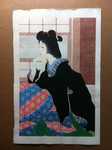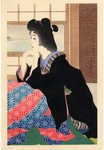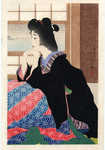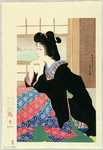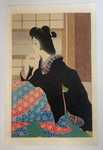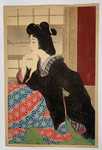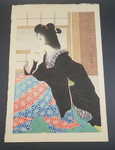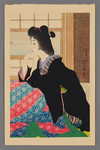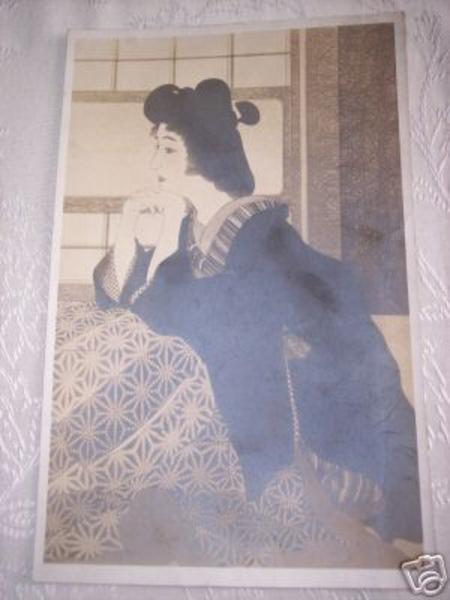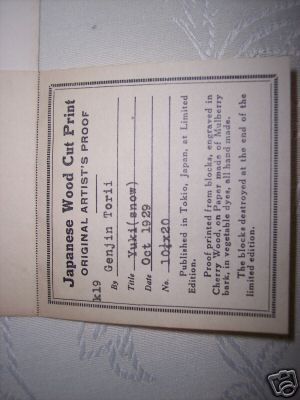| | |
| Artist: | Torii Kotondo (1900-1976) — 鳥居言人 |
| Title: | Snow (Yuki) — 雪 |
| Series: | |
| Date of first edition?: | 1929 |
| Publisher (first edition)?: | Sakai and Kawaguchi — 酒井川口 |
| Publisher (this edition)?: | Unknown — 不明 |
| Medium (first edition): | Woodblock |
| Medium (this edition): | Machine Printing |
| Format (first edition): | Large Oban
|
| Format (this edition): | Large Oban |
| DB artwork code: | 33758 |
| Notes (first edition)?: |
Artist Torii Kotondo
Title: "Yuki" (Snow)
A lady is warming herself under a "kotatsu" (Japanese traditional foot warmer usually built into the floor). The snow is falling outside.
Publisher Sakai/Kawaguchi
Medium Original Limited Edition Japanese Woodblock Print
Date: October 1929.
Sheet size: 18-1/4 x 11-3/4"
Notes: Embossed title in the lower margin reads: "Yuki".
Dated and signed in the upper right: Showa 4 (1929), followed by the circular artist's seal reading: "Kotondo".
First printed as a 300 sheet domestic edition and a 200 print export edition.
Reference No. Female Image #172
Re-issued in the series "Twelve Aspects of Women" circa August 23, 1988. |
|
| Notes (this edition)?: |
| The following information was taken from the original web listing of this artwork. Note that there may be some inaccuracies:
Tuesday, 14 March 2006
As you can see from the picture, attached to the back of the picture (it folds down), is a label that reads 'Japanese Wood Cut Print, Original Artist's Proof, k19, By Genjin Torii, Title Yuki (snow), Date Oct 1929, No 10-1/4x20, Published in Tokio, Japan, at Limited Edition. Proof of printed from blocks, engraved in Cherry Wood, on Paper made of Mulberry bark, in vegetable dyes, all hand made. The blocks destroyed at the end of the limited edition.'
Also stamped on the back is KAWAGUCHI Shokai, 56 East Randolph St., Chicago, Ill. (I did not take a picture of this. The overall condition is very good although there are some creases on the print (noticable when holding at an angle in light???) and it seems to need some cleaning (looks like greasy finger prints…possibly???).
The print measures approx 9-15/16" tall x 6-3/8" wide. I do not know anything else about this jem other than what I have stated.
I am putting this revision in my listing. It is a copy of a question I received (also at the bottom of page) and my answer…obviously, I am no expert on these matters and I described the item by the tag attached. I try to be as honest as possible in all my listing and I thought the below may be important. Q: Hello, Do you think this may be a machine-printed print, not a woodblock? If you hold the paper up to strong light, can you see lines (called chain lines) running through the paper? I'm wondering whether this is actually a picture of the original, much larger, woodblock print. Cheers. Mar-12-06
A: Hello and thank you for the inquiry. I just followed your suggestion and held the picture up to a naked lightbulb, and no, I do not see lines running thru the paper. I by no means meant to be misleading, I was just describing the listing by the attached (and pictured) tag that is attached to the picture. I am going to cut/paste your question and my answer in the listing itself. Again thank you for the inquiry. G
|
|
| Artist Bio: |
| Torii Kotondo (or Torii Kiyotada VIII) is renowned for his paintings and shin hanga prints of beautiful women. His woodblock prints, superbly carved and printed, are comparable with those of Hashiguchi Goyo and Ito Shinsui. Kotondo was born with the name Saito Akira in the Nihonbashi district of Tokyo. He was the only son among the five children of Torii Kiyotada, the seventh Torii master. The Torii school had a long tradition of painting and printmaking for the Japanese theater, extending back to the seventeenth century. Kabuki theater was still very popular in the early twentieth century and prints and painted posters were the primary means of publicity. Although Kotondo was mainly interested in studying history and archaeology, it was assumed that he would follow in his father's footsteps and join the Torii school. At age 14, Kotondo agreed to leave school and begin studies with Kobori Tomone, a yamato-e painter. Along with painting classes, Tomone taught Kotondo about the court and military practices of ancient Japan, satisfying his interest in history. A year later, he was officially adopted as the next heir of the Torii school and assumed the artist's name 'Kotondo'. While still studying with Tomone, he began designing illustrations for a theatrical magazine, Engei Gaho ('Entertainment Illustrated Magazine'), and painted kabuki posters and billboards. Torii Kotondo was the 8th Torii and the 5th Torii Kiyotada. His father was the 4th Kiyotada.
|
|



